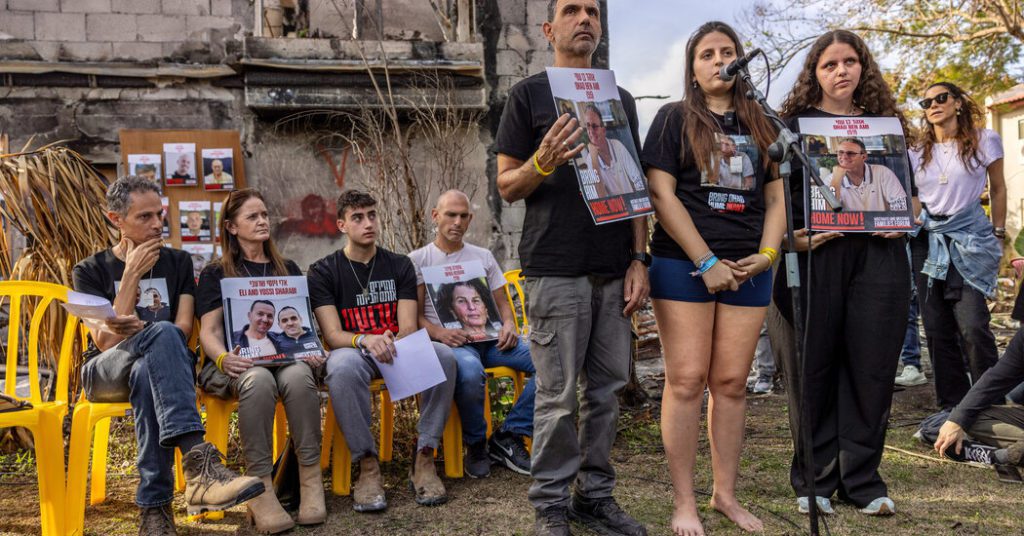Ahmed Fouad Al-Khatib was at his home in San Francisco when the panicked calls started. On Thursday, an Israeli air strike hit his family’s home in Rafah, in the so-called safe zone in the Gaza Strip, where hundreds of thousands of people have taken refuge to escape the war.
His phone was soon filled with news clips from home, where he would go to family barbecues and play with his grandmother’s ducks. He watched neighbors scramble over the smoking ruins, searching for survivors.
Instead, he added, they found at least 31 bodies, including two women in their 70s, several people in their 60s, and nine children between the ages of 3 months and 9 years. More are still missing. He learned the names of the dead through text messages and Facebook updates, spread over hours and days.
“It was disgusting and nauseating,” said Al-Khatib, 33, a writer and outspoken critic of Hamas, who received asylum in the United States after the militant group seized power in Gaza in 2007. “My heart was beating out of breath.” “Control with anxiety and fear. These are the people I grew up with. It was a family home.”
The raid that killed several members of Mr. Khatib’s family is one of several in recent weeks that hit areas where the Israeli military told people to go to avoid air strikes, raising questions about the advice and the safety of those who followed it.
The war began on October 7, when militants led by Hamas attacked Israel, killing nearly 1,200 people and taking 240 hostage. Since then, the UN says, the Israeli army has carried out a massive air campaign and ground offensive that has displaced 1.9 million people, about 85% of Gaza’s population. The campaign led to the deaths of about 20,000 people, according to officials in Gaza, and the eradication of entire branches of family trees. It also destroyed the civilian infrastructure and economy in the Strip and paralyzed hospitals.
Azmi Kishawi, a researcher at the International Crisis Group, an independent research organization, said from Rafah that he witnessed three air strikes there last week: one on Sunday that killed 21 people, one on Monday that killed 11 people, and one on Tuesday that killed 15 people.
He added, “The situation on the ground in Rafah is not calm to this degree.”
Nir Dinar, spokesman for the Israeli army, said that Israel had taken “important steps to urge civilians in the northern Gaza Strip to move towards a safer area in southern Gaza, as well as taking possible measures to mitigate collateral damage to civilians and civilians.” property during its operations.”
He declined to answer questions about the air strikes in Rafah, but said: “Unfortunately, Hamas is stationed in safer areas as well, and is choosing to do so at the expense of the safety of the people of Gaza.”
Before the war, the population of Rafah District – about a third the size of Brooklyn – was about 260,000 people. But in recent weeks, hundreds of thousands of people have fled towns to the north, and there are now signs that public order is beginning to collapse.
Last week, Philippe Lazzarini, head of the United Nations Relief and Works Agency for Refugees, told reporters that during his recent visit to Rafah, he witnessed Gazans stopping aid trucks, attacking their food and immediately devouring it.
“They are so desperate and hungry,” he added. “Everywhere you go, people are hungry, desperate and terrified.”
Mr. Kishawi, the researcher, said that he fled his home in Gaza City, north of the Strip, and now lives in a tent on the Rafah sidewalk with his family. He added that it does not seem that anyone in Rafah, located on the border with Egypt, is “prepared to receive this number of people.”
“The living conditions in the shelters are really miserable,” he said. “They have a lot of diseases. You have to line up for hours to go to the bathroom. There is a lack of hygiene, a lack of services provided by the United Nations to clean garbage. Dirty water runs between the tents.”
When the airstrike hit the Al-Khatib family home on December 14, dozens of people were inside, and many more were in the backyard. He said this was a reflection of the difficult conditions in Rafah and the generosity of his uncle, Dr. Abdullah Shehadeh, 69, and his aunt, Zainab, 73, who were killed in the raid.
Al-Khatib said: “I opened the house to dozens of people. If a building remains standing, people put pressure on it, and this is a common feature of what is happening now in southern Gaza.”
He added that his aunt was a retired teacher at a United Nations school, and his uncle was a well-known doctor. Also among the dead were two other of his aunts, Fatima Nasman, 76, and Hind Nasman and his uncle Hassan Nasman, both in their 60s. Among the dead were also several children, including his 3-month-old cousin, Elaine, and his 4-month-old cousin, Ella.
Mr. Al-Khatib said he knew of no justification for the strike: the house was not being used by Hamas.
Al-Khatib said: “I tell you from my heart, nothing happened there.” “Even if there is a Hamas man passing by, do not destroy an entire house and kill everyone in it.”

“Infuriatingly humble alcohol fanatic. Unapologetic beer practitioner. Analyst.”








More Stories
BBC on board a boat chased by China in the South China Sea
Odessa: “Harry Potter Castle” in Ukraine catches fire after Russian missile attack kills 5 people
The war between Israel and Hamas: Netanyahu pledges to invade Rafah “with or without a deal”